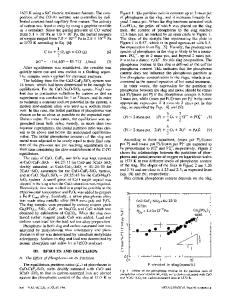Electrical Properties of Na 2 O - SiO 2 Dried Gels
- PDF / 341,350 Bytes
- 6 Pages / 414.72 x 648 pts Page_size
- 53 Downloads / 416 Views
ELECTRICAL PROPERTIES OF Na2 0 - SiO2 DRIED GELS D. RAVAINE,* J. TRAORE,* L. C. KLEIN** AND I. SCHWARTZ** *Laboratoire d'Energetique Electrochimique ENSEEG BP 75 38402, Saint Martin d'Heres FRANCE "**Rutgers University, Department of Ceramics, P.O. Box 909, Piscataway, NJ 08854, USA ABSTRACT Gels with compositions Na20-(1-x)Si0 2 were prepared from tetraethylorthosilicate (TEOS) with sodium acetate and from tetramethylorthosilicate (TMOS) with sodium methoxide or TEOS with sodium ethoxide. After gelation (10 min.) the samples were slowly dried for about one month at room temperature. Thermogravimetric analysis (up to 500 0 C) in air and 02 atmosphere was performed. The electrical properties were studied in air by impedance spectroscopy during successive temperature cycles starting from room temperature dried gels of composition 0.10 Na2 0*".9O Si0 2 . Protonic conductivity appears to be eliminated after reaching the 2nd stage of the drying process (200 0 C). The activation energies for conduction and the conductivities show small discrepancies from known values for homogeneous glasses of equivalent compositions. Considering the effect of water on the conductivity of glasses prepared by the melting procedure, one can estimate the residual water content in the so-called dried gels to be close to 0.5 wt %. INTRODUCTION Improving the ionic conductivity of glasses has been the subject of numerous works these last ten years. Fast ion conducting glasses have now entered the field as promising candidates for energy storage and other applications [1-3]. The conductivity enhancement has been obtained through progress in glass chemistry: sulfide glasses or HX (M: alkali or silver: X: halogen) doped-glasses have lead to a considerable increase of conductivity compared to the previously investigated binary oxide glasses. Further improvement is now limited by the choice of available compositions which can be prepared by conventional melting. For instance, solid ionic salts which decompose at low temperature, cannot be incorporated into traditional glasses while they are known to enhance the conductivity when added into ion-conducting solid polymers. From this point of view, the sol-gel process appears as an attractive method for preparing new glass compositions with improved ionic conductivities. Another interesting point comes immediately to mind: full densification may not be a necessary step to produce a suitable solid electrolyte. Typically in solid state ionic devices, the ionic conductor used as an electrochemical membrane must fulfill the following requirements: 1) to be free of any mobile water or solvent molecules which would be easily electrolysed in high voltage cells; 2) to be single ion conducting in order to prevent any spurious redox reactions at either electrode; 3) to exhibit an extremely low electronic contribution to the conductivity.
Mat.
Mes.
Soc. Symp. Proc.
Vol.
32 (1984)
Published by Elsevier Science Publishing Co.,
Inc.
140
This paper presents an investigation of the effect of thermal treatment
Data Loading...











